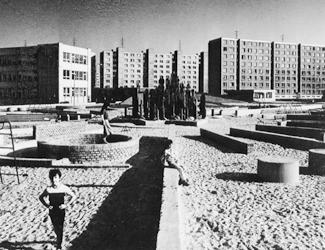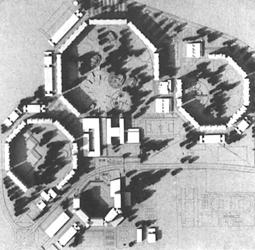| address architect project realization |
Bratislava II, Podunajské Biskupice architect Štefan Svetko, Štefan Ďurkovič, State Institute of Design and Standardisation Research, Bratislava 1973 1973 – 1977 |
As one of the most radically conceived urban structures in the city, the residential complex Medzi jarkami is one of the most daring realisations of the post-war years. Though it did make use of the standard typologies of prefabricated apartment blocks, their potential to defi ne a public space was developed fully by the architects in the unusual grouping into futuristic-looking clusters. What emerged were three large octagonal blocks with extensive interior spaces in the form of semi-open courtyards. This partial openness is the most important feature of the concept: the spaces are not isolated, communicating with the surroundings not only visually but also physically, in the sense of pedestrian movement around the estate. The courtyards, indeed interior spaces, are designed as spaces for recreation and sport, to support children’s creativity and receptiveness to art. The largest courtyard in Bieloruská ulica received its own artifi cial hillocks for sledding, cycling routes, castle with palisades, and the object of a “fl ying saucer”, of which only a fragment remains. Essential to the original concept was the exclusion of automobile transport and parking to the edges of the residential structure. Medzi jarkami is a characteristic instance of truly complex apartment construction, intended to address the problem of housing, even in the form of a relatively distant urban satellite, for the growing population of Bratislava in close proximity to the recreation area of the Vrakunský lesík area.
Literature:
Ehrenberger, Imrich: Monumentálna kompozícia bytovej zóny. Projekt 18, 1976, 8 – 9, s. 10.
DULLA, Matúš – MORAVČÍKOVÁ, Henrieta: Architektúra Slovenska v 20. storočí. Bratislava, Slovart 2002, 512 s.
Moravčíková Henrieta a kol.: Bratislava Atlas sídlisk. Bratislava, Slovart 2011, s. 335.
Source of pictures:
Department of Architecture Archive, ÚSTARCH SAV


